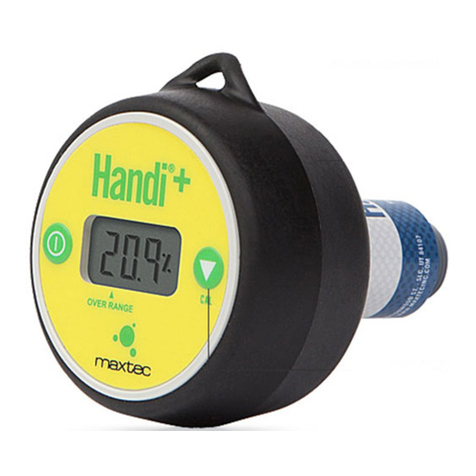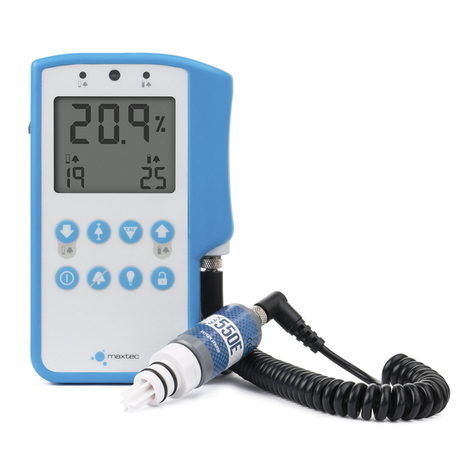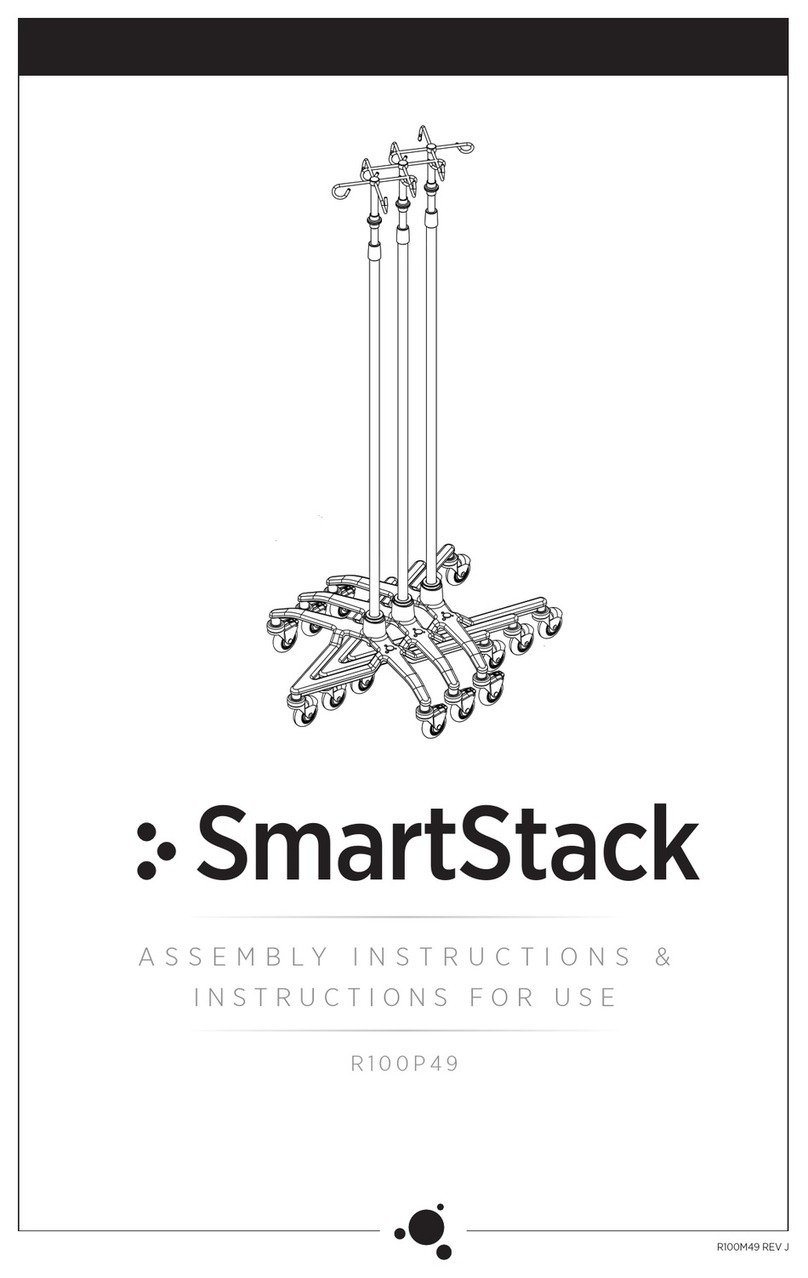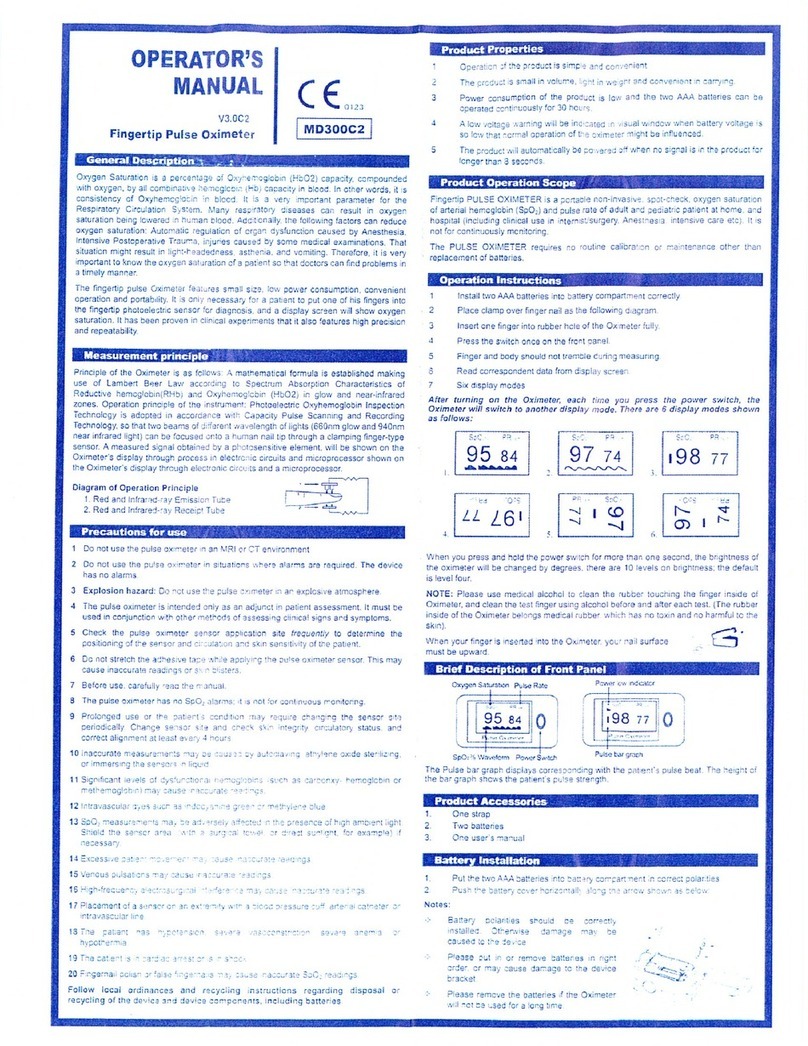
ENGLISH 4WWW.MAXTEC.COM • (800) 748-5355
3.0 OPERATING THE HANDI+
To Check the Oxygen Concentration of a Sample Gas:
1. Maintain the Handi+ in an upright position such that you can read the product
label.
2. Place the Handi+ in the sample gas stream.
IMPORTANT: When using a standard "T" adapter, make sure that the sensor is mounted in the
adapter with the flow diverter pointing down. Make sure that there is a tight fit between the
flow diverter and the "T" adapter.
3. Start the flow of the sample gas to the sensor.
4. Allow the oxygen sensor to remain in the flow of the sample gas until stable.
5. If the Handi+ is not already turned on, do so now by pressing the analyzer ON
button .
6. Read the value displayed on the LCD.
NOTE: If the Handi+ is used to measure the oxygen concentration with equipment using a
heated or humidified gas stream, it is recommended that the Handi+ be placed upstream of
the heater and/or humidifier. For more information, refer to "Factors Influencing Calibration
and Performance" below.
For hospital and home care a new calibration is required when:
•The measured O2 percentage in 100% O2 is below 97.0% O2
•The measured O2 percentage in 100% O2 is above 103.0% O2.
For ID testing (or optimum accuracy), a new calibration is required when:
7. The measured O2 percentage in 100% O2 is below 99.0% O2.
8. The measured O2 percentage in 100% O2 is above 101.0% O2.
4.0 FACTORS INFLUENCING
ACCURATE READINGS
4.1 Elevation Changes
•Changes in elevation result in a reading error of approximately 1% of reading per
250 feet.
•A change in altitude greater than 500 ft will require sensor recalibration.
•This device does not automatically compensate for changes in barometric pressure
or altitude. If the device is moved to a location of a different altitude, it must be
recalibrated before use (see section 2.2).
4.2 Temperature Effects
The Handi+ will hold calibration and read correctly within ±3% when in thermal equilibrium
within the operating temperature range. The device must be thermally stable when calibrated
and allowed to thermally stabilize after experiencing temperature changes before readings
are accurate. For these reasons, the following is recommended:
•When used in a breathing circuit, place the sensor upstream of the heater.
•For best results, perform the calibration procedure at a temperature close to the
temperature where analysis will occur.
•Allow adequate time for the sensor to equilibrate to a new ambient temperature.
4.3 Pressure Effect
Readings from the Handi+ are proportional to the partial pressure of oxygen. The partial pres-
sure is equal to the concentration times the absolute pressure. Thus the readings are pro-
portional to the concentration if the pressure is held constant. Flow rate of sample gas can
affect pressure at the sensor in that back pressure at the sensing point may change. For these
reasons, the following is recommended:
•Calibrate the Handi+ at the same pressure as the sample gas.
•If sample gases flow through tubing, use the same apparatus and flow rates when
calibrating as when measuring.
•The Handi+ oxygen sensor has been validated at pressures up to 2 atmospheres
absolute. Calibration or operation above this pressure is beyond the intended use.
4.4 Humidity Effect
Humidity has no effect on the performance of the Handi+ other than diluting the gas, as long
as there is no condensation. Depending on the humidity, the gas may be diluted by as much as
4%, which proportionally reduces the oxygen concentration. The device responds to the actual
oxygen concentration rather than the dry concentration. Environments where condensation
may occur are to be avoided since condensate may obstruct passage of gas to the sensing
surface, resulting in erroneous readings and slower response time.
For this reason, the following is recommended:
•Avoid usage in environments greater than 95% relative humidity.
•When used in a breathing circuit, place the sensor upstream of the humidifier.
5.0 CALIBRATION ERRORS AND
ERROR CODES
The Handi+ analyzers have a self test feature built into the software to detect faulty calibra-
tions, oxygen sensor failures, and low operating voltage. These are listed below, and include
possible actions to take, if an error code occurs.
E03: No valid calibration data available
Make sure unit has reached thermal equilibrium. Press and hold the Calibration Button for
three seconds to manually force a new calibration.
E04: Battery below minimum operating voltage
Unit is at end of life, see "Product Disposal Instructions" for proper disposal.
CAL Err St: O2 Sensor reading not stable
Wait for displayed oxygen reading to stabilize when calibrating the device at 100% oxygen.
Wait for unit to reach thermal equilibrium (Please note that this can take up to one half hour,
if the device is stored in temperatures outside the specified operating temperature range).
CAL Err lo: Sensor voltage too low
Press and hold the Calibration Button for three seconds to manually force a new calibra-
tion. If unit repeats this error more than three times, contact Maxtex Customer Service for
possible sensor replacement.
CAL Err hi: Sensor voltage too high
Press and hold the Calibration Button for three seconds to manually force a new calibra-
tion. If unit repeats this error more than three times, contact Maxtec Customer Service for
possible sensor replacement.
CAL Err Bat: Battery voltage too low to recalibrate
Unit is at end of life, see "Product Disposal Instructions" for proper disposal.
6.0 CLEANING AND MAINTENANCE
When cleaning or disinfecting the Handi+, take appropriate care to prevent any solution from
entering the analyzer.
•The Handi+ surface may be cleaned using a cloth moistened with 65% isopropyl
alcohol/water solution or germicidal wipe.
•The Handi+ may be disinfected using standard topical disinfectants.
•The Handi+ is not intended for steam, ethylene oxide or radiation sterilization.
•Store the Handi+ in a temperature similar to its ambient environment of daily use.






























